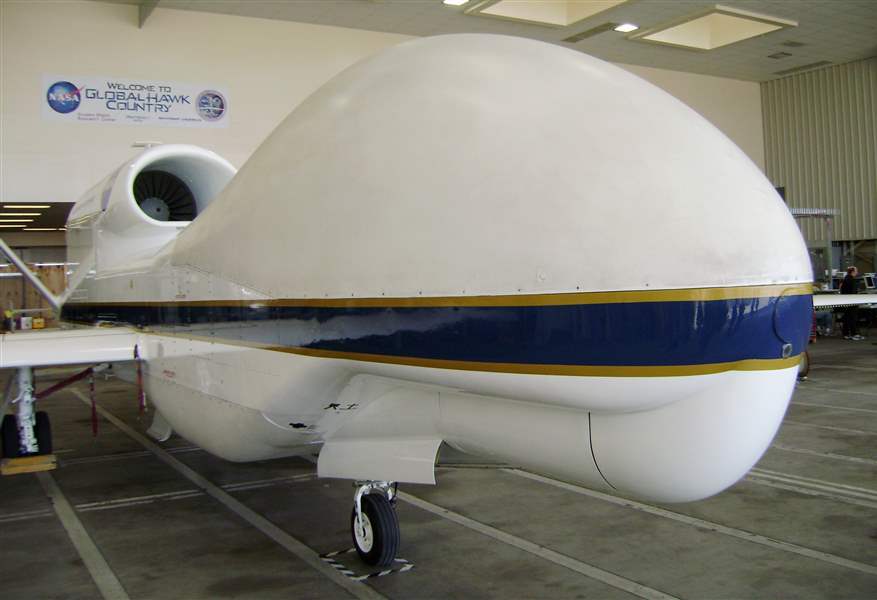
70,000 JOBS EXPECTED IN FIRST 3 YEARS
FAA names 6 states to develop coveted testing sites for drones
Ohio-Indiana joint bid rejected; Michigan’s also
12/31/2013
A NASA Global Hawk drone sits in a hangar at Dryden Flight Research Center at Edwards Air Force Base in California. The six states chosen to develop research sites for drones did not include California.
ASSOCIATED PRESS

A NASA Global Hawk drone sits in a hangar at Dryden Flight Research Center at Edwards Air Force Base in California. The six states chosen to develop research sites for drones did not include California.
CINCINNATI — Ohio and Indiana have lost out on their joint bid to secure one of the Federal Aviation Administration’s highly coveted test sites for unmanned aircrafts.
Michigan also had sought to be chosen too, but passed over as well.
The FAA on Monday announced six states that will develop test sites for drones, a critical next step for the march of the unmanned aircraft into U.S. skies.
Alaska, Nevada, New York, North Dakota, Texas, and Virginia will host the research sites, the agency said.
Members of Congress and other politicians lobbied intensely to bring the work to their states. Representatives were jubilant about the likelihood the testing will draw companies interested in cashing in on the fledgling industry.
An industry-commissioned study has predicted more than 70,000 jobs would develop in the first three years after Congress loosens drone restrictions for U.S. skies. The same study projects an average salary range for a drone pilot between $85,000 and $115,000.
Ohio and Indiana had hoped to improve their chances by combining forces and setting up the Ohio/Indiana UAS Center & Test Complex based in Springfield, Ohio.
The proposal included several test ranges in southwest Ohio and southeast Indiana.
U.S. Sen. Rob Portman (R., Ohio) said Ohio would have been a good choice because of its deep roots in aerospace, noting that it’s home to a U.S. Air Force research lab near Dayton and a NASA research center in Cleveland.
The FAA said its decisions were based on geography, climate, location of ground infrastructure, research needs, airspace use, aviation experience, and risk. “This is wonderful news for Nevada that creates a huge opportunity for our economy,” said U.S. Sen. Harry Reid (D., Nevada), the Senate majority leader. In New York, Sen. Charles Schumer, a Democrat, called the announcement a boon for his state.
The test-site selections come as the United States prepares to open its skies to the unmanned aircraft that industry experts predict will generate thousands of jobs and billions of dollars in economic impact.
The competition for a test site was robust: 25 entities in 24 states submitted proposals, FAA Administrator Michael Huerta said.
States hoped winning one of the test locations would attract drone-related businesses and help them become a key player in what some market analysts describe as the most dynamic growth sector of the world aerospace industry this decade.
At least one of the six sites chosen by the FAA will be up and running within 180 days, while the others are expected to come online in quick succession, Mr. Huerta said.
However, the designation as a test site doesn’t come with a financial award from the government.
Congress mandated that the FAA develop a plan by 2015 for safely integrating civilian drones into the national airspace, and the test sites are meant to ensure drones don’t endanger people, planes, or property.
U.S. Rep. Mike Turner (R., Dayton), who helped craft the legislation requiring test sites, said southwest Ohio still can play a role in the development in drones despite losing out on its bid.
“Our region will benefit from being on the cutting edge of innovation and development in unmanned system,” he said.
Military drones are increasingly being used overseas, and the FAA estimates as many as 7,500 small, commercial unmanned aircraft could operate domestically within the next few years.
Domestic drones, often resembling the remote-controlled model airplanes and helicopters flown by hobbyists, are expected to help monitor floods and other emergencies, survey crops, and assist search-and-rescue operations.
The growing use of drones has sparked criticism among conservatives and liberals who fear the creation of a surveillance state in which authorities track and scrutinize every move of citizens. “I just don’t like the concept of drones flying over barbecues in New York to see whether you have a Big Gulp in your backyard or whether you are separating out your recyclables according to the city mandates,” said Sen. Rand Paul (R., Ky.), referring to a New York City ban on supersized soft drinks.
Mr. Paul has introduced a bill to prohibit drones from checking for criminal or regulatory violations without a warrant.